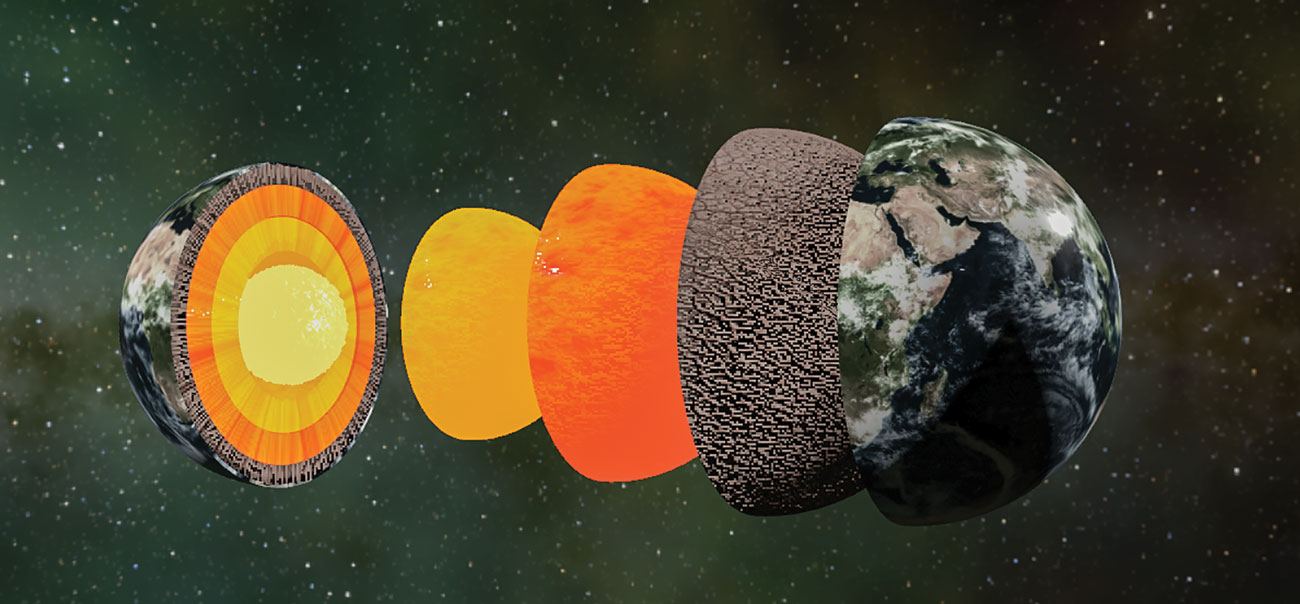Down The Rabbit Hole
First published in Sanctuary Cub,
Vol. 45
No. 3,
March 2025
By Rithwik Sundar
Our curiosity to explore the underground has been as strong as our desire to explore outer space! Despite our inability to travel to the Earth’s centre, scientific methods have allowed us quite a sneak peek into what lies beneath
Have you ever wondered if you dug a tunnel straight down from right below your feet, covering the distance of the Earth’s diameter, you would pop up somewhere else, maybe even at one of the poles? I certainly have thought about it when I got hold of a plastic globe in school. While astronauts have walked on the Moon, human bodies have not gone farther than four kilometres deep underground. We’ve drilled as deep as 12 km., which is about one-third of the way through the Earth’s crust, but the Earth’s core begins at around 2,900 km. further below.

The four layers of the Earth. Photo: Public Domain/A. Shteiwi.
Like Peeling An Onion
By studying seismic waves, the magnetic field, meteorites, and through computer modelling, we have discovered that our planet has four main layers. The crust is the thinnest layer, the one we walk on. How thick the Earth’s crust is depends on the location; for example, the crust under mountains is thicker, whereas it is thinnest under the ocean. While the continental crust is mostly made of granite, the oceanic crust is mostly basalt, and together they form only one per cent of Earth’s volume. All reserves of today’s fossil fuels are also found in Earth’s crust.
The layer beneath the crust, called the mantle, makes up a massive 84 per cent of the planet’s volume. The mantle is responsible for plate tectonics – the slow movement of slabs of rock on the surface, building mountains, causing continents to glide, and forming volcanoes.

Groundwater provides drinking water to over a quarter of the world’s population. Photo: Public Domain/Pexels.
The outer core, composed mostly of iron and nickel, lies beneath the mantle and is in a liquid state. It generates Earth’s magnetic field through its motion, which creates electric currents as the planet rotates. The inner core, owing to high pressure, is in a solid state. It is understood that as the liquid outer core solidifies and crystallises, the solid inner core expands by about one millimetre per year in radius. The Earth’s core is as hot as the surface of the Sun!

The Ozark blind cave salamander was first described in 1892. Photo: Peter Paplanus/CC-BY-2.0.
Life That Does Not Meet The Eye
While high temperatures, pressure, molten rock, and minerals exist in the underworld, it is not without life or barren. Below the ground, too, there is life, entire ecosystems, water, and processes that support life on Earth. In fact, the largest unfrozen source of freshwater available to us is groundwater, and more than half of all species live in soil. Groundwater provides drinking water to more than a quarter of the world’s population and supports around 40 per cent of all irrigated crops. Groundwater ecosystems, such as caves, where even surface light cannot reach, are home to a variety of life forms, including fish, salamanders, and insects. Most of these creatures might look bizarre, often colorless, have longer lifespans, and many are even blind. These creatures have evolved in isolation, adapting to the extreme conditions of the subterranean world, where food is scarce and darkness prevails. Many of these unique species remain to be discovered.

The largest unfrozen source of freshwater available to us is from the ground. Photo: Public Domain/Viviana Camacho/Pexels.
Digging Deep With Imagination
Dante Alighieri’s Inferno is perhaps the most famous literary depiction of the underground. This 14th century poem portrays the underground realm as Hell, guiding readers through its nine circles, where all sins are punished. Interestingly, Dante portrays the centre of the Earth as freezing cold and icy. Such depictions of the underground as rivers of fire and torturous chambers for sinners are nearly universal. Yet, no seismometer has ever detected so much as a human scream from beneath, firmly putting to rest any notion of hell lurking under our feet.

Earthworms play a vital role in maintaining soil health. Photo: Pfly/CC-BY-SA-2.0.
Even the recent Netflix show Stranger Things, a science fiction horror series about a group of friends, features an alternate reality called the ‘Upside Down’, a parallel world of fear and decay, into which the characters enter through underground gateways. In the 2008 adventure movie Journey to the Centre of the Earth, starring Brendan Fraser, the underworld is imagined as a place where dinosaurs still roam. Of course, if you dug into the planet, the only dinosaurs you’d find are their fossils!
Stay Grounded
~ When art, music, or cultural movements are niche or non-mainstream, they are referred to as ‘underground culture’.
~ The Paris Catacombs are an underground final resting place for over six million people.
~ Flint was one of the earliest materials mined by early humans for making stone tools.
While the world beneath our feet might not meet our eye, its resources surround our everyday life. From the copper in our cables to the water we drink, and even the squirmy earthworm that surfaces in our garden, the underground world is constantly influencing life above. Consider this edition of Sanctuary Cub, a secret portal, your Notes from the Underground!
Rithwik Sundar is an Assistant Editor at Sanctuary Asia. He enjoys walking in nature, watching birds, and looking for fish in streams. Most days, he is planning his next adventure into the wild. Lately, he’s also gotten into watching anime.






